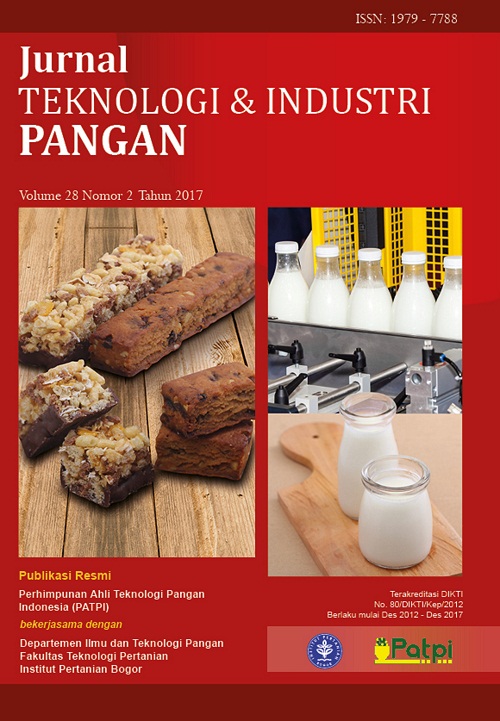DRAGON FRUIT JUICE ADDITION IN PALM OIL-PUMPKIN EMULSION: PANELIST ACCEPTANCE AND ANTIOXIDANT CAPACITY
Abstract
Addition of dragon juice to emulsion products formulated from olein fraction of red palm oil and pumpkin juice was conducted as an effort to improve the taste thus it can be accepted by consumers. This study aims to (1) observe the acceptance of 60 panelists aged 17-21 years on the parameters of taste, aroma, mouthfeel, color, flavor and aroma of each contributing components of dragon fruit, palm oil, and raspberry flavor with the addition of dragon fruit juice at level 0 (control), 25, 50, and 75% (v/v), and (2) observe the changes in chemical components i.e. vitamin C and total titrable acids, total carotenoid by spectrophotometry, and antioxidant activity by 2,2-diphenyl-1-picrylhdrazyl (DPPH) reduction method. The best formula was the one containing 75% (v/v) of red dragon juice in fresh condition with vitamin C content of 19.32±0.62 mg/100 mL, antioxidant activity of 354.25±0.77 ppm, hedonic color, taste, and viscosity between favorable and very favorable. After 2 weeks of storage at room temperature (28±2ºC), the vitamin C, total carotene, and antioxidant activity of the mixture decreased by 29.72, 15.44, and 46.59%, res-pectively.
References
Castro-López C, Sánchez-Alejo EJ, Saucedo-Pompa S, Rojas R, Aranda-Ruiz J, Martínez-Avila GCG. 2016. Fluctuations in phenolic con-tent, ascorbic acid and total carotenoids and antioxidant activity of fruit beverages during storage. Heliyon 2: 1-16. DOI: 10.1016/j.heliy on.2016.e00152.
Cervantes-Paz B, Ornelas-Paz JJ, Perez-Martínez JD, Reyes-Hernandez J, Zamudio-Flores PB, Ibarra-Junquera V, Ruiz-Cruz S. 2016. Effect of pectin concentration and properties on digestive events involved on micellarization of free and esterified carotenoids. Food Hydrocolloid 60: 580-588. DOI: 10.1016/j.foodhyd.2016.04.038.
Damodaran S, Arora A. 2013. Off-flavor precursors in soy protein isolate and novel strategies for their removal. Rev Food Sci Technol 4: 327–46. DOI: 10.1146/annurev-food-030212-182650.
Granato D, Branco GF, Nazzaro F, Cruz AG, Faria JAF. 2010. Functional foods and nondairy pro-biotic food development: trends, concepts, and products. Food Sci Food Saf 9: 292–302. DOI: 10.1111/j.1541-4337.2010.00110.x.
Isabelle M, Lee ML, Lim MT, Koh WP, Huang D, Ong CN. 2010. Antioxidant activity and profiles of common fruits in Singapore. Food Chem 123: 77–84. DOI: 10.1016/j.foodchem.2010.0 4.002.
Koca N, Burdurlu H, Karadeniz F. 2007. Kinetics of colour changes in dehydrated carrots. J Food Eng 78: 449–455. DOI: 10.1016/j.jfoodeng.200 5.10.014.
Lavelli V , Zanoni B, Zaniboni A. 2007. Effect of water activity on carotenoid degradation in dehydrated carrots. Food Chem 104: 1705–1711. DOI: 10.1016/j.foodchem.2007.03.033.
Martinez B, Rubio B, Viera C, Linares MB, Egea M, Panella-Riera N, Garrido MD. 2016. Evaluation of different strategies to mask boar taint in cooked sausage. Meat Sci 116: 26–33. DOI: 10.1016/j.meatsci.2016.01.006.
Mba OI, Dumont M, Ngadi M. 2015. Palm oil: Pro-cessing, characterization and utilization in the food industry – a review. Food Biosci 10: 26–41. DOI: /10.1016/j.fbio.2015.01.003.
Montenegro L, Rapisarda L, Ministeri C, Pugilisi C. 2015. Effects of lipids and emulsifiers on the Physicochemical and sensory properties of
cosmetic emulsions containing vitamin E. Cosmetics 2: 35-47. DOI: 10.3390/cosmetics2010035.
Nadya R. 2010. The Effect of knowledge education to mothers of under five year children to vitamin A capsule supplementation in sub-district of Medan marelan year of 2009. http://repository .usu.ac.id/handle/123456789/16580. [4 June 2014].
Nhung DTT , Bung PN, Nguyen Thu Ha NT, Phong TK. 2010. Changes in lycopene and beta caro-tene contents in aril and oil of gac fruit during storage. Food Chem 121: 326–331. DOI: 10.1016/j.foodchem.2009.12.032.
Plaza L, Sánchez-Moreno C, Ancos BD, Elez-Martínez P, Martín-Belloso O,
Cano MP. 2011. Carotenoid and flavanone content during refri-gerated storage of orange juice processed by high-pressure, pulsed electric fields and low pasteurization. LWT-Food Sci Technol 44: 834-839. DOI: 10.1016/j.lwt.2010.12.013.
[PORIM] Palm Oil Research Institute of Malaysia. 1995. Test Methods Carotene Content. Palm Oil Research Institute of Malaysia, Kuala Lum-pur. Malaysia
Qian C, Decker EA, Xiao H, Mc Clements DJ. 2012. Inhibition of β-carotene degradation in oil-in-water nano emulsions: Influence of oil-soluble and water-soluble antioxidants. Food Chem 135: 1036–1043. DOI: 10.1016/j.foodchem.20 12.05.085.
Rahmadi A, Puspita Y, Agustin S, Rohmah M. 2015. Panelists acceptance and chemical properties of pumpkin and palm olein fraction emulsion. J Teknol Industri Pangan 26: 201-210. DOI: 10.6066/jtip.2015.26.2.201.
Rutz JK, Borges CD, Zambiazi RC, Crizel-Cardozo MM, Kuck LS, Noreña CPZ. 2017. Microencap-sulation of palm oil by complex coacervation for application in food systems. Food Chem 220: 59–66. DOI: 10.1016/j.food chem.2016.09.194.
Sánchez-Moreno C, Plaza L, De Ancos B, Cano P. 2003. Vitamin C, pro-vitamin A carotenoid: and other carotenoids in high-pressurized orange juice during refrigerated storage. J Agr Food Chem 51: 647–653. DOI: 10.1021/jf020795o.
Sancho LEGG, Yahia EM, González-Aguilar GA. 2011. Identification and quantification of phe-nols, carotenoids, and vitamin C from papaya (Carica papaya L., cv. maradol) fruit determined by HPLC-DAD-MS/MS-ESI. Food Res Int 44: 1284–1291. DOI: 10.1016/j.foodres.2010.12.0 01.
Sahidi F, Zhong Y. 2010. Lipid oxidation and impro-ving the oxidative stability. Chem Soc Rev 39: 4067-4079. DOI: 10.1039/b922183m.
Soekarto ST. 1985. Organoleptic Analysis. 1-121. Pusat Pengembangan
Teknologi Pangan. IPB. Bogor.
Soukoulis C, Cambier S, Hoffmann L, Bohn T. 2016. Chemical stability and bioaccessibility of β-carotene encapsulated in sodium alginate o/w emulsions: Impact of Ca2+ mediated gelation. Food Hydrocolloid 57: 301-310. DOI: 10.1016/j. foodhyd.2016.02.001.
Sudarmadji S, Haryono B, Suhardi. 2007. Analytical Procedure for Food and Agricultural Material. 150-152. Liberty.Yogyakarta.
Thirugnanasambandham K, Sivakumar V. 2017. Microwave assisted extraction process of beta-lain from dragon fruit and its antioxidant activi-ties. J Saudi Soc Agric Sci 16: 41–48. DOI: 10.1016/j.jssas.2015.02.001.
Verrijssen TAJ, Verkempinck SHE, Christiaens S, Hendrickx ME. 2016. In vitro β-Carotene bio-accessibility and lipid digestion in emulsions: influence of pectin type and degree of methyl-esterification. Food Hydrocolloid 49: 73-81. DOI: 10.1111/1750-3841.13408.
[WHO] World Health Organization. 2009. Global Prevalence of Vitamin a Deficiency in Popula-tions at Risk: WHO Global Database on Vitamin A Deficiency, WHO, Geneva.

